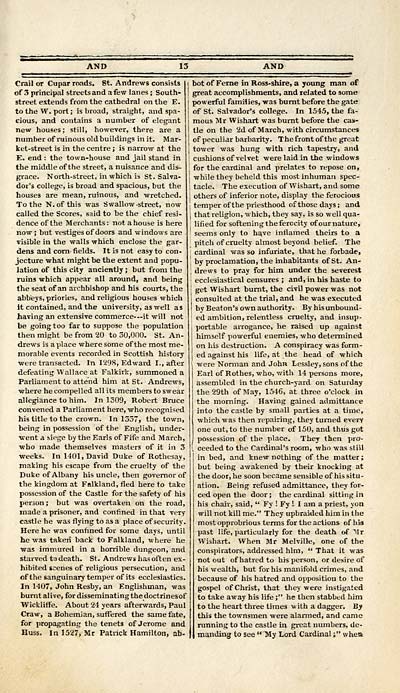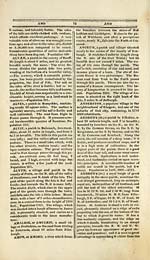Gazetteer of Scotland
(15) Page 13 - AND
Download files
Complete book:
Individual page:
Thumbnail gallery: Grid view | List view

AND
Crail or Cupar roads. St. Andrews consists
of 3 principal streets and a few lanes ; South- j j
street extends from the cathedral on the E.
to the W. port ; is hroad, straight, and spa-
cious, and contains a number of elegant
new houses; still, however, there are a
number of ruinous oldbuildings init. Mar-
ket-street is in the centre ; is narrow at the
E. end : the town-house and jail stand in
the middle of the street, a nuisance and dis-
grace. North-street, in which is St. Salva-
dor's college, is broad and spacious, but the
houses are mean, ruinous, and wretched.
To the N. of this was Swallow street, now
called the Scores, said to be the chief resi-
dence of the Merchants: not a house is here
now ; but vestiges of doors and windows are
visible in the walls which enclose the gar-
dens and corn fields. It is not easy to con-
jecture what might be the extent and popu-
lation of this city anciently ; but from the
ruins which appear all around, and being
the seat of an archbishop and his courts, the
abbeys, priories, and religious houses which
it contained, and the university, as well as
having an extensive commerce-— it will not
be going too far to suppose the population
then might be from 20 to 30,000. St. An-
drews is a place where some of the most me-
morable events recorded in Scottish history
were transacted. In 1298, Edward I., after
defeating Wallace at Falkirk, summoned a
Parliament to attend him at St. Andrews,
where he compelled all its members to swear
allegiance to him. In 1309, Robert Bruce
convened a Parliament here, who recognised
his title to the crown. In 1337, the town,
being in possession of the English, under-
went a siege by the Earls of Fife and March,
■who made themselves masters of it in 3
■weeks. In 1401, David Duke of Rothesay,
making his escape from the cruelty of the
Duke of Albany his uncle, then governor of
the kingdom at Falkland, fled here to take
possession of the Castle for the safety of his
person ; but was overtaken on the road,
made a prisoner, and confined in that very
castle he was flying to as a place of security.
Here he was confined for some days, until
he was taken back to Falkland, where he
was immured in a horrible dungeon, and
starved ta death. St. Andrews has often ex-
hibited scenes of religious persecution, and
of the sanguinary temper of its ecclesiastics.
In 1407, John Resby, an Englishman, was
burnt alive, for disseminating the doctrines of
Wickliffe. About 24 years afterwards, Paul
Craw, a Bohemian, suffered the same fate,
for propagating the tenets of Jerome and
Huss. In 1527, Mr Patrick Hamilton, ab-
13 AND
hot of Feme in Ross-shire, a young man of
great accomplishments, and related to some
powerful families, was burnt before the gate
of St. Salvador's college. In 1545, the fa-
mous Mr Wishart was burnt before the cas-
tle on the 2d of March, with circumstances
of peculiar barbarity. Thefront of the great
tower was hung with rich tapestry, and
cushions of velvet were laid in the windows
for the cardinal and prelates to repose on,
while they beheld this most inhuman spec-
tacle. The execution of Wishart, and some
others of inferior note, display the ferocious
I temper of the priesthood of those days ; and
j that religion, which, they say, is so well qua-
lified for softening the ferocity of our nature,
seems only to have inflamed theirs to a
pitch of cruelty almost beyond belief. The
cardinal was so infuriate, that he forbade,
' by proclamation, the inhabitants of St. An-
, drews to pray for him under the severest
ecclesiastical censures ; and, in his haste to
get Wishart burnt, the civil power was not
i consulted at the trial, and he was executed
! by Beaton's own authority. By his unbound-
ed ambition, relentless cruelty, and insup-
portable arrogance, he raised up against
himself powerful enemies, who determined
on his destruction. A conspiracy was form-
ed against his life, at the head of which
were Norman and John Lessley, sons of the
Earl of Rothes, who, with 14 persons more,
assembled in the church-yard on Saturday
the 29th of May, 1546, at three o'clock in
the morning. Having gained admittance
into the castle by small parties at a time,
which was then repairing, they turned every
one out, to the number of 150, and thus got
possession of the place. They then pro-
ceeded to the Cardinal's room, who was still
in bed, and knew nothing of the matter ;
but being awakened by their knocking at
the door, he soon became sensible of his situ-
ation. Being refused admittance, they for-
ced open the door ; the cardinal sitting in
his chair, said, " Fy ! Fy 1 I am a priest, yon
will not kill me." They upbraided him in tbe
most opprobrious terms for the actions of his
past life, particularly for the death of Mr
Wishart. When Mr Melville, one of the
conspirators, addressed him, " That it was
not out of hatred to his person, or desire of
his wealth, but for his manifold crimes, and
because of his hatred and opposition to the
gospel of Christ, that they were instigated
to take away his life ;" he then stabbed him
to the heart three times with a dagger. By
this the townsmen were alarmed, and came
running to the castle in great numbers, de-
manding to see " My Lord Cardinal ;" whea
Crail or Cupar roads. St. Andrews consists
of 3 principal streets and a few lanes ; South- j j
street extends from the cathedral on the E.
to the W. port ; is hroad, straight, and spa-
cious, and contains a number of elegant
new houses; still, however, there are a
number of ruinous oldbuildings init. Mar-
ket-street is in the centre ; is narrow at the
E. end : the town-house and jail stand in
the middle of the street, a nuisance and dis-
grace. North-street, in which is St. Salva-
dor's college, is broad and spacious, but the
houses are mean, ruinous, and wretched.
To the N. of this was Swallow street, now
called the Scores, said to be the chief resi-
dence of the Merchants: not a house is here
now ; but vestiges of doors and windows are
visible in the walls which enclose the gar-
dens and corn fields. It is not easy to con-
jecture what might be the extent and popu-
lation of this city anciently ; but from the
ruins which appear all around, and being
the seat of an archbishop and his courts, the
abbeys, priories, and religious houses which
it contained, and the university, as well as
having an extensive commerce-— it will not
be going too far to suppose the population
then might be from 20 to 30,000. St. An-
drews is a place where some of the most me-
morable events recorded in Scottish history
were transacted. In 1298, Edward I., after
defeating Wallace at Falkirk, summoned a
Parliament to attend him at St. Andrews,
where he compelled all its members to swear
allegiance to him. In 1309, Robert Bruce
convened a Parliament here, who recognised
his title to the crown. In 1337, the town,
being in possession of the English, under-
went a siege by the Earls of Fife and March,
■who made themselves masters of it in 3
■weeks. In 1401, David Duke of Rothesay,
making his escape from the cruelty of the
Duke of Albany his uncle, then governor of
the kingdom at Falkland, fled here to take
possession of the Castle for the safety of his
person ; but was overtaken on the road,
made a prisoner, and confined in that very
castle he was flying to as a place of security.
Here he was confined for some days, until
he was taken back to Falkland, where he
was immured in a horrible dungeon, and
starved ta death. St. Andrews has often ex-
hibited scenes of religious persecution, and
of the sanguinary temper of its ecclesiastics.
In 1407, John Resby, an Englishman, was
burnt alive, for disseminating the doctrines of
Wickliffe. About 24 years afterwards, Paul
Craw, a Bohemian, suffered the same fate,
for propagating the tenets of Jerome and
Huss. In 1527, Mr Patrick Hamilton, ab-
13 AND
hot of Feme in Ross-shire, a young man of
great accomplishments, and related to some
powerful families, was burnt before the gate
of St. Salvador's college. In 1545, the fa-
mous Mr Wishart was burnt before the cas-
tle on the 2d of March, with circumstances
of peculiar barbarity. Thefront of the great
tower was hung with rich tapestry, and
cushions of velvet were laid in the windows
for the cardinal and prelates to repose on,
while they beheld this most inhuman spec-
tacle. The execution of Wishart, and some
others of inferior note, display the ferocious
I temper of the priesthood of those days ; and
j that religion, which, they say, is so well qua-
lified for softening the ferocity of our nature,
seems only to have inflamed theirs to a
pitch of cruelty almost beyond belief. The
cardinal was so infuriate, that he forbade,
' by proclamation, the inhabitants of St. An-
, drews to pray for him under the severest
ecclesiastical censures ; and, in his haste to
get Wishart burnt, the civil power was not
i consulted at the trial, and he was executed
! by Beaton's own authority. By his unbound-
ed ambition, relentless cruelty, and insup-
portable arrogance, he raised up against
himself powerful enemies, who determined
on his destruction. A conspiracy was form-
ed against his life, at the head of which
were Norman and John Lessley, sons of the
Earl of Rothes, who, with 14 persons more,
assembled in the church-yard on Saturday
the 29th of May, 1546, at three o'clock in
the morning. Having gained admittance
into the castle by small parties at a time,
which was then repairing, they turned every
one out, to the number of 150, and thus got
possession of the place. They then pro-
ceeded to the Cardinal's room, who was still
in bed, and knew nothing of the matter ;
but being awakened by their knocking at
the door, he soon became sensible of his situ-
ation. Being refused admittance, they for-
ced open the door ; the cardinal sitting in
his chair, said, " Fy ! Fy 1 I am a priest, yon
will not kill me." They upbraided him in tbe
most opprobrious terms for the actions of his
past life, particularly for the death of Mr
Wishart. When Mr Melville, one of the
conspirators, addressed him, " That it was
not out of hatred to his person, or desire of
his wealth, but for his manifold crimes, and
because of his hatred and opposition to the
gospel of Christ, that they were instigated
to take away his life ;" he then stabbed him
to the heart three times with a dagger. By
this the townsmen were alarmed, and came
running to the castle in great numbers, de-
manding to see " My Lord Cardinal ;" whea
Set display mode to: Large image | Transcription
Images and transcriptions on this page, including medium image downloads, may be used under the Creative Commons Attribution 4.0 International Licence unless otherwise stated. ![]()
| Gazetteers of Scotland, 1803-1901 > Gazetteer of Scotland > (15) Page 13 - AND |
|---|
| Permanent URL | https://digital.nls.uk/97421874 |
|---|

